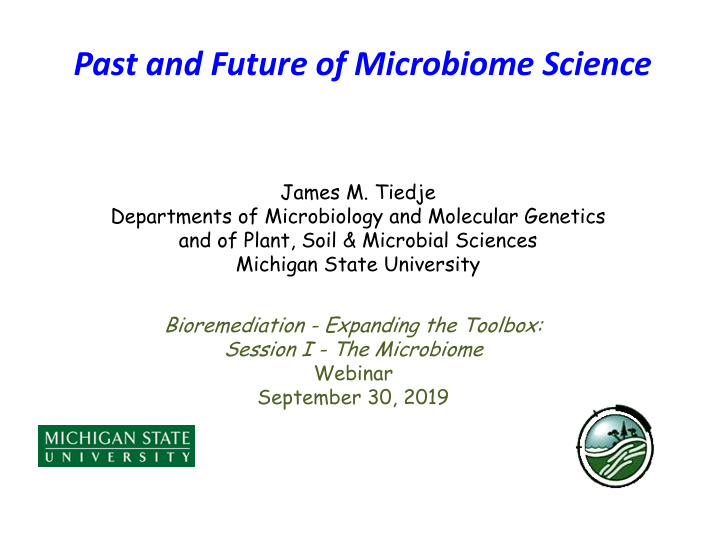



Past and Future of Microbiome Science James M. Tiedje Departments of Microbiology and Molecular Genetics and of Plant, Soil & Microbial Sciences Michigan State University Bioremediation - Expanding the Toolbox: Session I - The Microbiome Webinar September 30, 2019
To Understand the Microbial World Interactions with environment: biotic & abiotic 10 12 Species* Molecular detail of representative organisms * Locey and Lennon PNAS 2016
Possible Shifts in Emphasis as the Field of Metagenomics Develops Community metabolism Resources / Effort Community signaling Experimental Community gene structure Evolution Computational Molecular structure + function Ecological determinants Sequencing Global patterns Single cell Single molecule 0 5 10 Now here NRC Report on “The Years New Science of Metagenomics” Shift in branding to “Microbiome ” 2007
Era’s in Microbial Ecology: Technology Enabled 1960-70’s: Functions/processes; incubations*, isolates; isotopes, gas/liq chromatography, auto analyzers 1980’s: Math models, kinetics*; PCs 1990’s: Genes: DNA extraction, hybridization, 16S, machine sequencers, internet 2000’s: Genome sequences**: HTP sequencing, assembly 2010’s: MetaG, T, P , metabolomics: Low cost HTP sequence, HPCs 2020’s: ??? *Suflita, Horowitz, Shelton, Tiedje, 1982, Dehalogenation: Novel pathway for anaerobic biodegradation. Science , 218;1115 **Chain…Tiedje, et.al., 2006, Burkholderia xenovorans LB400 (PCB degrader) harbors a multi-replicon, 9.73-Mbp genome shaped for versatility. PNAS, 103:15280
My Themes 1. Untapped organismal and genetic diversity 2. Technology enabled, what is next? 3. Microbiomes; community-based activities
Genetic Traits Important to Biodegradation 1. Enzyme (the catalyst for bioconversion) - Its kinetics 2. Regulation (of gene expression) 3. Permease (transport into the cell) 4. Detergent production 5. Chemotaxis (movement to the pollutant) 6. Resistances - heavy metals - solvents - acidity, salt - heat 7. Attach or non-attaching microbes
Commonality of Midwest Soil Bacterial Populations Samples from: Rank of abundance • Kansas, Iowa, Wisconsin variable I1_13 • Native prairie 1e+00 I2_13 Rank Abundance • >100 year of cultivation IC0_01 Abundance IC0_03 of 16S rRNA Overlap by state in number IC10_03 IC10 phylotypes of sequences in common IC1 log-log scale IN0_01 phylotypes IN1_03 IN10 1e − 02 Abundance IN1 IN2_03 KC0_01 KC10 KC1 KN0_01 KN10 Community structure KN1 from 3 g of soil WC0_01 1e − 04 WC10 over 4 orders WC1 WN0_01 of magnitude WN10 WN1 1e+01 Rank 1e+03 1e+05 Rank (log)
How Diverse are Microbiomes at the Gene Level ? Iowa Soil SOIL LAKES GUT AMD • Practical outcomes are related to microbiome complexity • 0.6 – 1 Tbp for U.S Midwest prairie soil* Fig: Rodriquez-R and Konstantinidis, Bioinformatics , 2013 Nonpareil: a redundancy-based approach to assess the level of coverage in metagenomic datasets *Rodriguez_R, et.al, mSystems , 2018; an advanced algorithm
Comparison of Nonpareil sequence diversity (Nd) and 16S rRNA Shannon H’ taxonomic diversity indices on 86 metagenomes 16S rRNA- H’ Rodriguez-R et. al... Tiedje Konstantinidis mSystems , 2018 Metagenome Nd (α diversity)
The Microbial World Grows ~8,000 new genomes from metagenomes 17 new Bacterial Phyla Parks…Hugenholtz, Tyson 3 new Archaeal Phyla Nature Microbio, Sept 2017 Known as UBA’s Uncultured Bacteria & Archaea (from MAGs)
Nucl Acids Res, 2018 11
Recommend
More recommend